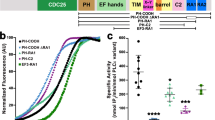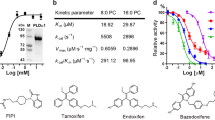Abstract
The structure of the PH-domain truncated core of rat phosphoinositide-specific phospholipase C-δ1 has been determined at 2.4 Å resolution and compared to the structure previously determined in a different crystal form. The stereochemical relationship between the EF, catalytic, and C2 domains is essentially identical. The Ca2+ analogue Sm3+ binds at two sites between the jaws of the C2 domain. Sm3+ binding ejects three lysine residues which bridge the gap between the jaws and occupy the Ca2+ site in the apoenzyme, triggering a conformational change in the jaws. The distal sections of the C2 jaws move apart, opening the mouth by 9 Å and creating a gap large enough to bind a phospholipid headgroup.
This is a preview of subscription content, access via your institution
Access options
Subscribe to this journal
Receive 12 print issues and online access
$189.00 per year
only $15.75 per issue
Buy this article
- Purchase on Springer Link
- Instant access to full article PDF
Prices may be subject to local taxes which are calculated during checkout
Similar content being viewed by others
References
Rhee, S.G. & Choi, K.D. Regulation of inositol phospholipid-specific phospholipase C isozymes. J. Biol. Chem. 267, 12393–12396 (1992).
Lee, S.B. & Rhee, S.G. Significance of PIP2 hydrolysis and regulation of phospholipase C isozymes. Curr. Opinion Cell Biol. 7, 183–189 (1995).
Yagisawa, H. et al. Expression and characterization of an inositol 1,4,5-trisphosphate binding domain of phosphatidylinositol-specific phospholipase C-δ1 . J. Biol. Chem. 269, 20179–20188 (1994).
Garcia, P. et al. The pleckstrin homology domain of phospholipase C-δ1 binds with high affinity to phosphatidylinositol 4,5-bisphosphate in bilayer membranes. Biochemistry 34, 16228–16234 (1995).
Paterson, H.F. et al. Phospholipase C δ1 requires a pleckstrin homology domain for interaction with the plasma membrane. Biochem. J. 312, 661–666 (1995).
Essen, L.-O., Perisic, O., Cheung, R., Katan, M. & Williams, R.L. Crystal structure of a mammalian phosphoinositide-specific phospholipase Cδ. Nature 380, 595–602 (1996).
Sutton, R.B., Davletov, B.A., Berghuis, A.M., Sudhof, T.C. & Sprang, S.R. Structure of the first C2 domain of synaptotagmin I: a novel Ca2+/phospholipid-binding fold. Cell 80, 929–938 (1995).
Newton, A.C. Seeing two domains. Current Biol. 5, 973–976 (1995).
Ponting, C.P. & Parker, P. Extending the C2 domain family: C2s in PKCs δ, ε, η, θ, phospholipases, GAPs, and perforin. Prot. Sci. 5, 162–166 (1996).
Eck, M.J., Atwell, S.K., Shoelson, S.E. & Harrison, S.C. Structure of the regulatory domains of the src-family tyrosine kinase lck. Nature 268, 764–769 (1994).
Maignan, S. et al. Crystal structure of the mammalian Grb2 adaptor. Science 268, 291–293 (1995).
Hatada, M. et al. Molecular basis for interaction of the protein tyrosine kinase ZAP-70 with the T-cell receptor. Nature 377, 32–38 (1995).
Eck, M.J., Pluskey, S., Trub, T., Harrison, S.C. & Shoelson, S.E. Spatial constraints on the recognition of phosphoproteins by the tandem SH2 domains of the phosphatase SH-PTP2. Nature 379, 277–280 (1996).
Takenawa, T., Homma, Y. & Emori, Y. Properties of phospholipase C isozymes. Methods Enzymol. 197, 511–517 (1991).
Nakashima, S. et al. Deletion and site-directed mutagenesisof EF-hand domain of phospholipase C-δ1: effects on its activity. Biochem. Biophys. Res. Comm. 211, 364–369 (1995).
Ellis, M.V., Carne, A. & Katan, M. Structural requirements of phosphatidylinositol-specific phospholipase Cδ1, for enzyme activity. Eur. J. Biochem. 213, 339–347 (1993).
Davletov, B.A. & Sudhof, T.C. A single C2 domain from synaptotagmin I is sufficient for high affinity Ca2+/phospholipid binding. J. Biol. Chem. 268, 26386–26390 (1993).
Chapman, E.R. & Jahn, R. Ca2+-dependent interaction of the cytoplasmic region of synaptotagmin with membranes. J. Biol. Chem. 269, 5735–5741 (1994).
Clark, J.D. et al. A novel arachidonic acid-selective cytosolic PLA2 contains a Ca2+-dependent translocation domain with homology to PKC and GAP. Cell 65, 1043–1051 (1991).
Nafelski, E.A. et al. Delineation of two functionally distinct domains of cytosolic phospholipase A2, a regulatory Ca2+-dependent lipid-binding domain and a Ca2+-independent catalytic domain. J. Biol. Chem. 269, 18239–18249 (1994).
Matthews, B.W. & Weaver, L.H. Binding of lanthanide ions to thermolysin. Biochemistry 13, 1719–1725 (1974).
Grobler, J.A. & Hurley, J.H. Expression, characterization, and crystallization of the catalytic core of rat phosphatidylinositide-specific phospholipase C δ1 . Prot. Sci. 5, 680–686 (1996).
Cifuentes, M.E., Honkanen, L. & Rebecchi, M.J. Proteolytic fragments of phosphoinositide-specific phospholipase C-δ1 . J. Biol. Chem. 268, 11586–11593 (1993).
Herzberg, O., Moult, J. & James, M.N.G. A model for the Ca2+-induced conformational transition of troponin-C. J. Biol. Chem. 261, 2638–2644 (1986).
Zhang, M., Tanaka, T. & Ikura, M. Calcium-induced conformational transition revealed by the solution structure of apo calmodulin. Nature Struct. Biol. 2, 758–767 (1995).
Kuboniwa, H. et al. Solution structure of calcium-free calmodulin. Nature Struct. Biol. 2, 768–776 (1995).
Faber, H.R. & Matthews, B.W. A mutant T4 lysozyme displays five different crystal conformations. Nature 348, 263–266 (1990).
Davletov, B.A. & Sudhof, T.C. Ca2+-dependent conformational change in synaptotagmin I. J. Biol. Chem. 269, 28547–28550 (1994).
Swairjo, M.A., Concha, N.O., Kaetzel, M.A., Dedman, J.R. & Seaton, B.A. Ca2+-bridging mechanism and phospholipid head group recognition in the membrane-binding protein annexin V. Nature Struct. Biol. 2, 968–974 (1995).
Bazzi, M.D. & Nelsestuen, G.L. Protein kinase C interaction with calcium: a phospholipid-dependent process. Biochemistry 29, 7624–7630 (1990).
Orr, J.W. & Newton, A.C. Interaction of protein kinase C with phosphatidylserine. 1. Cooperativity in lipid binding. Biochemistry 31, 4667–4673 (1992).
Newton, A.C. and Keranen, L.M. Phosphatidyl-L-serine is necessary for protein kinase C's high-affinity interaction with diacylglycerol-containing membranes. Biochemistry 33, 6651–6658 (1994).
Mosior, M. & Epand, R.M. Mechanism of activation of protein kinase C: roles of diolein and phosphatidylserine. Biochemistry 32, 66–75 (1993).
Fukuda, M., Kojima, T. & Mikoshiba, K. Phospholipid composition dependence of Ca2+-dependent phospholipid binding to the C2A domain of synaptotagmin IV. J. Biol. Chem. 271, 8430–8434 (1996).
Otwinowski, Z. DENZO. A program for automatic evaluation of film densities. Dept. of Molecular Biophysics and Biochemistry, Yale University, New Haven, CT. (1988).
Navaza, J. AMoRE- an automated package for molecular replacement. Acta Crystallogr. A50, 157–163 (1994).
Brünger, A.T. X-PLOR Version 3.1. A system for x-ray crystallography and NMR. Yale University Press, New Haven, CT. (1992).
Collaborative Computational Project, No. 4. The CCP4 Suite: Programs for protein crystallography. Acta Crystallogr. D50, 760–763 (1994).
Read, R.J. Improved Fourier coefficients for maps using phases from partial structures with errors. Acta Crystallogr. A42, 140–149 (1986).
Tronrud, D.E., Ten Eyck, L.F. & Matthews, B.W. An efficient general-purpose least squares refinement program for macromolecular structures. Acta Crystallogr. A43, 489–501 (1987).
Engh, R.A. & Huber, R. Accurate bond and angle parameters for X-ray protein-structure refinement. Acta Crystallogr. A47, 392–400 (1991).
Jones, T.A., Zou, J.Y., Cowan, S.W. & Kjelgard, M. Improved methods for building protein models in electron density maps and the location of errors in these models. Acta Crystallogr. A47, 110–119 (1991).
Laskowski, R.A., MacArthur, M.W., Moss, D.S. & Thornton, J.M. PROCHECK- a program to check the stereochemical quality of protein structures. J. Appl. Crystallogr. 26, 283–291.
Kraulis, P. MOLSCRIPT- a program to produce both detailed and schematic plots of protein structures. J. Appl. Crystallogr. 24, 946–950 (1991).
Carson, M. Ribbon models of macromolecules. J. Mol. Graphics 5, 103–106 (1987).
Author information
Authors and Affiliations
Rights and permissions
About this article
Cite this article
Grobler, J., Essen, LO., Williams, R. et al. C2 domain conformational changes in phospholipase C-δ1. Nat Struct Mol Biol 3, 788–795 (1996). https://doi.org/10.1038/nsb0996-788
Received:
Accepted:
Issue Date:
DOI: https://doi.org/10.1038/nsb0996-788
This article is cited by
-
Vesicle trafficking and vesicle fusion: mechanisms, biological functions, and their implications for potential disease therapy
Molecular Biomedicine (2022)
-
The Nedd4 family of E3 ubiquitin ligases: functional diversity within a common modular architecture
Oncogene (2004)
-
Structural characteristics of protein binding sites for calcium and lanthanide ions
JBIC Journal of Biological Inorganic Chemistry (2001)
-
Structure of the Janus-faced C2B domain of rabphilin
Nature Cell Biology (1999)
-
Lymphocyte granule-mediated cell death
Springer Seminars in Immunopathology (1998)



